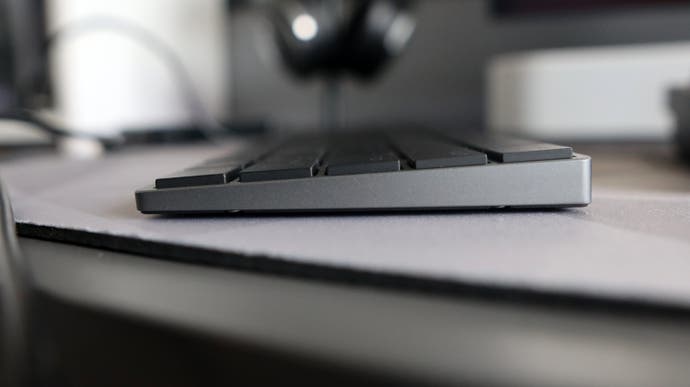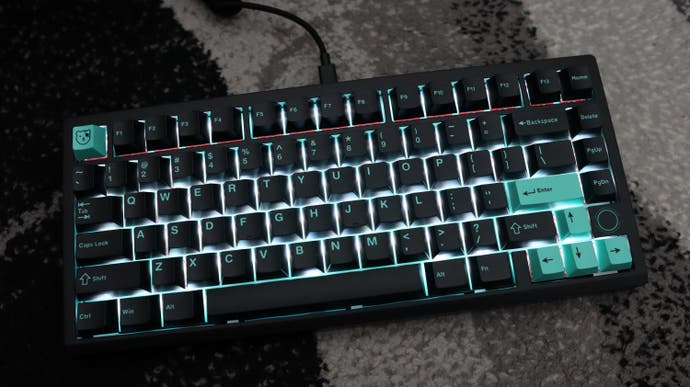What is an enthusiast-grade mechanical keyboard? It depends on what you’re into – it might be a super-fast gaming board for esports, an ultra low-profile work keyboard equally adept for Mac or Windows, or even a full-fat custom keyboard with unique switches and a compact form factor. Today we’ve got examples of all three, giving you an idea of what sorts of keyboards are out there and which you might prefer.
Here are three reviews then: the low-profile Mistel AirOne, the rapid trigger Meletrix BOOG75 and the custom-built Keychron Q1 Pro with MX Purple switches designed by Cherry and British keyboard maker Glarses. All are fascinating options in their own right, showing the breadth of the enthusiastic keyboard market in spring 2024.
Mistel AirOne review: An ultra slim and slender keyboard with sublime switches
Buy:
First up is the Mistel AirOne, an ultra low-profile and small form factor keyboard from Mistel, a brand who have been in the keyboard space for longer than a lot of their contemporaries. The AirOne is a bit of a rare beast, being one of only a handful of keyboards that packs in Cherry’s MX Ultra Low Profile switches. It comes with either MX ULP Clicky or Tactile, the former of which I don’t believe is available elsewhere in any other standalone keyboard.
This is a 65 percent keyboard, offering a convenient space-saving layout with some creature comforts in the form of arrow keys and an array of integrated functions. It’s a gorgeous space-gray keyboard that fits well in terms of color with modern Macs, and also has the benefit of working with either Mac or Windows. With that smaller size, it also fits well on the keyboard tray of my 16-inch MacBook Pro, although the USB-C only connection is a bit of a pain if you wanted something wireless. At least you get two ports to choose from for use. For the sake of portability, Mistel also bundles a nice bag with the AirOne if you want to take it on your travels. The machined aluminum chassis feels sturdy, and there isn’t any deck flex to speak of either. It’s especially pleasant to see machined aluminum on a board as small as this, given it’s usually applied to options that are a lot bigger and thicker than this one.

Speaking of thickness, the AirOne is one of the thinnest mechanical options available at just 5.08mm at its thinnest point. It’s a real marvel of engineering, and it’s in large part because of the super-slender MX ULP switches inside. My sample came with the more commonly available MX ULP Tactile switches inside, which offer a supremely positive actuation with a snappy keypress and a rounded tactility that feels more akin to an MX Clear in full-size form. They’re excellent switches for productivity workloads – this very article has been typed up on that lovely Mistel – and are some of my favorite switches at the moment alongside Halo Trues and Drop Pandas. I like soft tactile switches, if you couldn’t tell.
Elsewhere, the AirOne features full RGB backlighting, which at first can be a little offputting due to its constant color changing, although there are several different presets available if you want something a little less in your face. These are similar to presets found on more affordable keyboards, if that’s what you’re into. There is also the ability to program on-board macros, too, which is easy enough to do.
Overall, Mistel’s AirOne is an excellent ultra low profile mechanical keyboard that adds yet another compelling option to its class. It may be quite expensive, but for the price, you’re getting a sublime typing experience in a small form factor layout that’s well apart from other options.
Meletrix BOOG75 review: Hall effect switches in a massive aluminum case

Buy:
Admittedly, before checking out the BOOG75, I hadn’t had many dealings with Meletrix. I’d heard excellent things about their most standard offering, the Zoom75, which has been a hit with enthusiasts far and wide. I guess that their thought process with their latest release was: “What if we added hall effect switches with rapid trigger into a massive aluminum case?”. Or, if it wasn’t that, I’d wager it was something rather similar.
The BOOG75 retains Meletrix’s reputation for offering incredible buid quality with one of the thickest and heaviest machined aluminum cases I’ve experienced on a keyboard, full stop. A weight of around 3kg makes this insanely heavy, and means you could conceivably use the BOOG75 as a weapon if you wanted. Elsewhere, its black and turquoise colorway looks excellent, and the sci-fi type accents on the side, back and underside of the case complete the look nicely. The keycaps themselves look and feel like they are made of durable PBT plastic, and carry a textured finish, which feels excellent under finger. Elsewhere, the BOOG75 comes with some handy accessories, including a big carry bag, as well as a braided, coiled USB-C cable, in-keeping with this being an enthusiast-level keyboard.
Inside, the BOOG75 features Gateron’s KS-37B switches, which have become known as a reliable hall-effect switch and has been featured in other keyboards I’ve tested such as the Endgame Gear KB65HE. They’re a responsive switch that feels especially smooth under finger, arguably as you’d expect given that there is no physical mechanism here.
These switches come with the convenience of adjustable actuation points and rapid trigger functionality for offering an incredibly snappy gaming experience. Adjustable actuation points mean that you can change the point at which an input is registered, and on these switches, there isn’t any limitation on distance – it can be anywhere from 0.1mm down to 4mm, or from the very beginning to the end of the key travel. Rapid trigger essentially means you can set the distance of the actuation as well as when the switch resets for near-instant keypresses. Setting it to 0.1mm on both downstroke and reset should therefore result in some incredibly snappy inputs.
This certainly became true in testing the mighty BOOG75 in CS2, having the rapid trigger mapped for movement keys and for selecting weapons was rather handy in quick draw scenarios, while being able to change the actuation point in BeamNG Drive for keys around the WASD keys for movement to prevent accidental keypresses worked a treat.

All of the configuration for both the switches themselves and the BOOG75’s RGB lighting is taken care of in a dedicated microsite. Here, programming travel distances, the rapid trigger, and the BOOG75’s per-key RGB lighting is reasonably simple across four different profiles, although setting the rapid trigger requires you to stumble through three layers of menus before setting the distance – it’s actually hidden in the ‘Advanced’ section. The RGB lighting, in itself, is more of an underglow with the solid keycaps present here. The default white setting is smart, although there are all manner of presets and options for even more RGB-based goodness if you’d like it.
$230 isn’t cheap for the BOOG75, considering you can get other hall-effect keyboards from more reputable brands including Razer, SteelSeries and Wooting for around the same price which come with more advanced features including analog capabilities for more progressive inputs. Elsewhere, the likes of the Endgame Gear KB65HE offer most of the BOOG75’s feature set with the same switches and an aluminum case for almost half the price. While this is an excellent keyboard in its prebuilt form, it is an expensive one.
Keychron Q1 Pro (custom) review: My own personal beast, with some rather interesting switches
-1.jpg?width=690&quality=75&format=jpg&auto=webp)
Buy:
Out of the box, the Keychron Q1 Pro is one of the best value high-end mechanical keyboards, with a sturdy aluminum frame, comfortable K Pro Brown switches and convenient wireless connectivity and compatibility with both Windows and macOS. Since reviewing it in stock form though, I’ve added on GMK’s Laser keycaps, specifically the Drop + MiTo GMK Laser Gaijin option with Hiragana sub-legends, as well as some silly novelty keys for nav cluster functions and the Blocknet set for a lot of the keys around the perimeter of the board. Mixing up two keycap sets is hardly the cheapest way to do it, but the doubleshot ABS keycaps feel excellent under finger and are durable too so I’m happy with the result.
It’s inside where I’ve changed things the most, however. While I’ve stuck with soft tactile switches, the standard K Pro Browns have been changed over to a special MX variant. In-keeping with the color theme, my Q1 Pro has the special Cherry MX Purple keyswitch inside, a fun collaboration between the folks at Cherry and Glarses, a keyboard-based YouTuber who is genuinely one of the wackiest people on the platform. While his legendary hatred for MX Browns is something I personally disagree with, the MX Purples he and the Cherry MX department have cooked up are a fantastic soft tactile keyswitch.
-11.jpg?width=690&quality=75&format=jpg&auto=webp)
His aim to make them more tactile than MX Browns has succeeded. These MX Purples have a great deal more in the way of tactility, with a more pronounced bump, which is more akin to the brand’s own newer Ergo Clears. There looks to be a degree of similarity between the two switches, as well as between Purples and the older, standard MX Clears. The stem is the same, which for some members of the community, has led to MX Purples breaking their keycaps. This was an issue I’d heard from Clears previously, although with my extended use of both switches over months (and years with MX Clears), I personally haven’t had any game-breaking issues, although these Purple switches do fit tighter onto my keycaps than other MX switches I’ve used in the past.
Besides this, MX Purple uses a longer spring than previous MX switches, in the name of providing a speedier return for the switch to its natural position. This is also technically an MX2A switch, bringing with it the notable gains we’d seen previously with the KC 200 MX, a new ‘board from Cherry that Will looked last year that shipped with newer MX2A Browns. For most of us, the difference here is factory lubrication for a smoother keypress that sits well alongside my other experiences with MX2A. It isn’t entirely smooth, with some initial scratchiness, but after breaking the switches in, the MX Purples felt responsive and excellent to use for an extended period.
-2.jpg?width=690&quality=75&format=jpg&auto=webp)
Usually with the keyboards I come into contact with, they either get used for a few weeks and get boxed back up and sent back from whence they came. On the occasion they get kept however, they are usually swapped out for another option from my collection. However, while the name of modifying my Q1 Pro was for the purposes of covering the MX Purples in a keyboard, I can’t help but have fallen in love with it over the last few weeks and months of use. The modifications have made a great keyboard an arguably near-perfect one for me, and I can’t see it moving from my desk any time soon.
So, there you have it. Three small and reasonably short reviews of some keyboards I’ve indulged in testing over the last few months. If you’ve got any recommendations for other products for Will or I to test, feel free to drop them in the comments below or pester me on Twitter @RBithrey.
#Keyboards #big #small #enthusiast #options #reviewed #spring